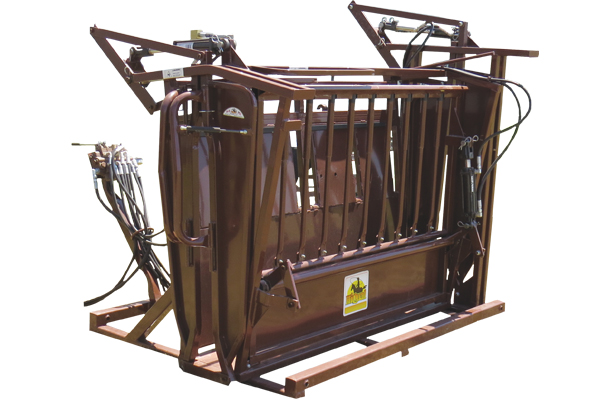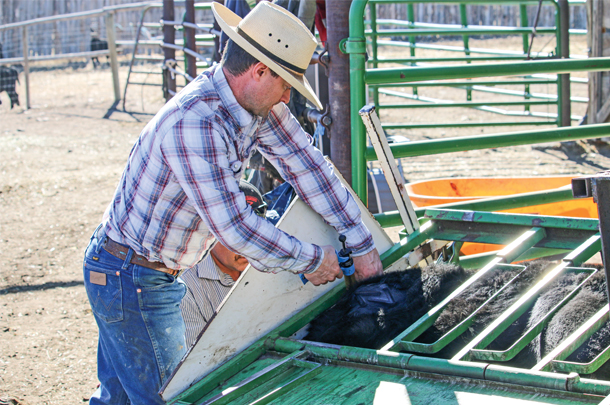Tilt tables for calves have been in use for a long time, and today some producers are using hydraulic calf tables.
Phil Rupp of Rupp Manufacturing Company in Cherokee, Iowa, has been selling hydraulic calf tables since 2007. “The advantages are that they are fast and there’s not much effort required to operate them.
All you have to do is pull a lever; you don’t have to physically manhandle the calf or tip one. The head catch, belly catch and tipping is all hydraulic. Our tables accommodate calves up to about 300-pound calves,” he says.
The table is also reversible if you need to brand on the other side. “The belly catch is in the middle, and you simply move the neck catch from one end of the table to the other and run the calf in from the other direction. You can run the calves in from the other side or turn the table around,” he explains.
“You can process 100 calves an hour, and we have done as many as 125 per hour. We were castrating, notching ears, branding and vaccinating – but not dehorning. Half the calves were heifers, so that saves time (no castration),” says Rupp.

Mike Schroeder, HiQual territory manager for Oregon, Idaho, Utah, Nevada and California, says hydraulic tilt tables are a unique product because not many people are manufacturing them. “Ours works similarly to a manual calf table, but the operator uses levers that are similar to those on a large hydraulic cattle chute."
"There’s a lever that works the head catch, one that works the tail gate, squeeze and levers that allow the table to be hydraulically tipped so the calf is lying horizontally,” he says. This is much easier than doing it manually.
“Ours is probably one of the largest, longest, lightest ones. The hydraulics will handle a 600- to 650-pound calf quite easily, but it’s physically harder to get these large calves in or out of the chute. By contrast, you could work 450-pound calves all day long without problems,” he says.
Heidi Carroll, livestock stewardship extension associate, South Dakota State University, says that when using hydraulic equipment, make sure you know how to set it for the right amount of pressure.

“Be sure it is adjusted to the width and height of the calves. Like a hydraulic squeeze chute, there’s a range of control in which you can make small adjustments to the pressure."
"It’s often a matter of just being aware that you don’t always have to hold the hydraulic lever down as long to catch the bigger calves effectively; you just need to get it closed. If the calf is still fighting, tap the lever a little more to find the right pressure that enables the calf to relax. Usually the animal’s behavior will be a clue. If there are calves vocalizing, this is usually an indication of pain and distress, and you need to check pressure setting,” says Carroll.
“The hydraulics are adjustable for operating speed and clamp pressure,” says Rupp. “If you have bigger calves, you can turn the pressure up a little so it will pick them up and lay them down better, and hold them more securely. For smaller calves, you can back the pressure off so you don’t have to worry about mashing one,” he says.
There are several styles of hydraulic calf tables. When comparing and figuring out what might work best for your operation, look at the sidebars. “Evaluate the amount of access and how quickly you can access the animal to do the needed tasks,” says Carroll. “If you only need to brand, it will be different than if you also have to castrate,” she says. Some tables also have a shelf to support the calf’s head when the chute is tilted.
Rupp says that with some of the manual calf tables, the whole thing tips over, and then you have to open a door to get to the part of the calf you need to work on. “This can be hazardous when you have several people working around it, getting fingers slammed in doors, etc. Ours are safer because there is nothing to move out of the way.”
“We did not make the tail gate hydraulic; you still have to manually open the rear door and the head gate to let the calf out. We do that for safety because if you have people pulling levers and someone in the way, they could get hurt. Sooner or later, somebody would have an arm in the wrong place,” Rupp says.
“These tables will run off any machinery with hydraulic systems – tractor, skid loader or bale bed with an engine-driven pump. (It won’t work with a 12-volt pump because they can’t run continually like a belt-driven pump.) A lot of people just park next to it and run the hoses over,” says Rupp.
“We also sell a little 110-volt electric pump to run it. Some people have gas engine-driven pumps. These can be used where there’s no electricity. Some people use the electric pumps and a generator.” Hydraulic chutes are portable and could be taken to remote locations to use in conjunction with a portable corral.
“Our chute gives several options for a power source,” says Schroeder. “It comes with 25 feet of hose and standard Pioneer couplers. These can be hooked up to a small tractor if it has hydraulics. It can sit there and idle and run the chute. You don’t need a lot of hydraulic flow – only about 7 or 8 gallons per minute."
"Another option is our 220-volt electric portable power unit. This includes an electric motor, pump and reservoir for hydraulic fluid. This can be located in a barn or shed next to where you are working cattle to have noise and vibration farther away from the animals, to reduce stress,” he explains. It could be run off a generator, as well.
“As a third option, to make it portable, we offer a 6.5-horsepower Honda gas unit. It has the same pump and reservoir, attached to this motor. This little power unit puts out plenty of flow to run our calf table or our large cow hydraulic chute. We also have a trailer kit for portability,” Schroeder says.
“For handler safety, make sure everyone on your crew understands where the moving parts are,” says Carroll. Have a “walk-through” demonstration before you start working calves.
Easy on your back
“We’re all getting older,” says Rupp. “It’s harder to manually work cattle. This is why we invented our hydraulic table. A lot of ranchers can no longer come up with enough help to rope and drag calves for branding,” he says.
There are also more females in the cattle industry today. “A hydraulic table may improve efficiency in processing calves, no matter who is on the team,” says Carroll. “Hydraulic tables don’t put limitations on who may be capable of operating it. It might be a good long-term investment,” she says.
Hydraulic calf tables retail at about $6,750 for just the table. The electric power unit for HiQual’s table is $1,800 and a gas-powered unit is $2,225.
“People look at the price and get a bit of sticker shock, but if you look at reduced stress/wear and tear on the calf and less wear and tear on you, and safety issues, it becomes more attractive,” says Schroeder.
“All it takes is one accident caused by fatigue and strain (that results in a trip to the ER or puts you out of action for a while), and this calf table becomes relatively cheap real quick,” he says.
Renting one might be a possibility, depending on where you are located. “A few dealers in the Midwest have rented them to ranchers, and there are a few veterinary clinics that rent them out,” he says. If you only have to work cattle once a year, this might be something to consider.
“I have also seen two or three neighbors go together and buy a calf table and trailer,” says Schroeder. “They help each other work calves anyway, so they just take it around to wherever they’ll be working calves that day. This makes it less expensive for everyone.” ![]()
Heather Smith Thomas is a freelance writer based in Idaho.
PHOTO 1& 2: HiQual’s standard hydraulic calf table. Photos by Mike Schroeder.
PHOTO 3: To be safe, be sure to know which parts are moving on calf tables. Staff photo.







